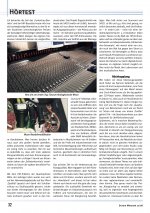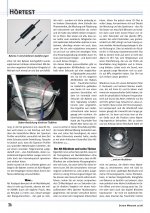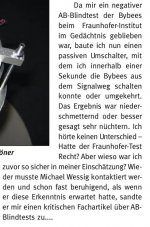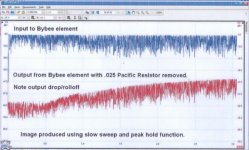I have heard the terms 'tizzy' and 'tizziness' used since I can remember, and I also have used those terms since I can remember....to me a perfectly valid descriptor of hashy, uncontrolled and false highs.
Please read my post in http://www.diyaudio.com/forums/everything-else/173453-bybee-q-p-listening-tests-2.html#post2571448
Eric.
Please read my post in http://www.diyaudio.com/forums/everything-else/173453-bybee-q-p-listening-tests-2.html#post2571448
Eric.
I see dead people.
Yes it is nice to support the family at the funeral.
But Jack Btbee from all reports is still alive and having fun.
Cal, I think has found the wisdom not to anger any of the three Bybee camps too much.
It's what I have Cal, but if you went back to the source (magazine article) you might be able to get a reasonable translation. In fact, I will personally send you the whole article in PDF, if that will be useful to you. Jack was very surprised about this article when it came out, and I think it was this guy or his friends who took one apart and put it on the internet.
There are bits missing from the german article posted, there should be 5 pages.
The first two pages are unrelated blurb in which he is trying to prove his credentials as a professional authority.
Either way the guy who wrote it didn't hear any difference between with Bybee or without unless he looked, same result as the Fraunhofer Institute got when they conducted blind tests of aforementioned device (mentioned in the text).
He claimed that when listening to a whole album without Bybee followed by a break and then the album with the Bybee that the stereo field sounded somewhat wider.
He was later convinced by an 'audiophile' buddy of his that DBTs are somewhat flawed for unknown reasons.
Doesn't really add anything in the greater scheme of things.
Back to square one I think.
Personally I'm not sure I'd trust the ears of someone who is using a Tascam M700.
It is a piece of '80s pro-sumer gear not worth the re-capping which certainly would be necessary by now. Seen two for sale over the years, one a 40ch for Aus$2500 and an 80ch for Aus$4000. Neither sold and to put it in perspective a 40ch SSL console of the same vintage would set you back around £35 000.
The first two pages are unrelated blurb in which he is trying to prove his credentials as a professional authority.
Either way the guy who wrote it didn't hear any difference between with Bybee or without unless he looked, same result as the Fraunhofer Institute got when they conducted blind tests of aforementioned device (mentioned in the text).
He claimed that when listening to a whole album without Bybee followed by a break and then the album with the Bybee that the stereo field sounded somewhat wider.
He was later convinced by an 'audiophile' buddy of his that DBTs are somewhat flawed for unknown reasons.
Doesn't really add anything in the greater scheme of things.
Back to square one I think.
Personally I'm not sure I'd trust the ears of someone who is using a Tascam M700.
It is a piece of '80s pro-sumer gear not worth the re-capping which certainly would be necessary by now. Seen two for sale over the years, one a 40ch for Aus$2500 and an 80ch for Aus$4000. Neither sold and to put it in perspective a 40ch SSL console of the same vintage would set you back around £35 000.
Personally I'm not sure I'd trust the ears of someone who is using a Tascam M700.
We're just trying to hear a difference here. FWIW I used a Tascam PA30 and a Scythe Kama Bay. I wasn't too worried, I wanted to experience what these purifiers were capable of and for someone (not you CD) to suggest you need a really good system to experience the real value is bassackwards if you ask me.
I didn't mean that with regards to the Bybee, just generally and possibly with the first two pages in mind. The Bybee is only mentioned in the last page.
IMO if there is no audible difference in a DBT to all intents and purposes there is no difference. Personally I don't trust my ears alone because I know what I change in my stereo and realize how strong and inescapable expectation bias is.
For example I changed the opamps in my xovers but I would not claim any improvement publicly unless it was confirmed by others who have no idea what I've done or indeed if I have changed anything at all.
As it happened a friend of mine came over and within seconds he asked me if I had changed anything because my stereo sounded quite a bit better to him then it did a couple of days earlier. I had replaced TLO72s and LF353s with OPA2134s btw.
IMO if there is no audible difference in a DBT to all intents and purposes there is no difference. Personally I don't trust my ears alone because I know what I change in my stereo and realize how strong and inescapable expectation bias is.
For example I changed the opamps in my xovers but I would not claim any improvement publicly unless it was confirmed by others who have no idea what I've done or indeed if I have changed anything at all.
As it happened a friend of mine came over and within seconds he asked me if I had changed anything because my stereo sounded quite a bit better to him then it did a couple of days earlier. I had replaced TLO72s and LF353s with OPA2134s btw.
Attachments
Text, page 1, Google translate:
Let's be honest! , That time 'the world of music was still in-order, as you quite Fruh (since 1956) with the so-called IRT requirement specification (Institute for the radio technology) uniformly high Qualitätsanforde-ments for with respect to the studio engineering, sound technology equipment' Deputy - te, as then our equipment was called in German. And Prussian-German ßisch was equally as in the technical sense. It was a clear and strict Qualitätsanforderung be züglich the general VALID studies ONORM and their Qualitätsparameter
agreed. Background was of course primarily aims during biking a high compatibility of technical devices to gewährleisten within the broadcasting insti-tutions. Yet it was here a significant step further, because outside of the still familiar terms and standards as distortion, Übersprechen, external voltage distance, common-printing onto and frequency response, provided the IRT also clear demands on the acoustic environment in both the government as also the Aufnahmeräume. They wanted a one-here during biking
guarantee comprehensive Produktionsum acoustic field. By that time I also mean the beginning of the stereo-Epo-tion about the mid-60s. Broadcasting and Tonträgerindustrie sa-tion together the need for high quality Stere-ONORM and this could very quickly establish itself in solidarity. The Ste-reofonie was plain and simple a-ne sensation and is still the undisputed führende Tonträger format remained, despite 5.1 home theater systems and multi-channel SACD.
Let's be honest! , That time 'the world of music was still in-order, as you quite Fruh (since 1956) with the so-called IRT requirement specification (Institute for the radio technology) uniformly high Qualitätsanforde-ments for with respect to the studio engineering, sound technology equipment' Deputy - te, as then our equipment was called in German. And Prussian-German ßisch was equally as in the technical sense. It was a clear and strict Qualitätsanforderung be züglich the general VALID studies ONORM and their Qualitätsparameter
agreed. Background was of course primarily aims during biking a high compatibility of technical devices to gewährleisten within the broadcasting insti-tutions. Yet it was here a significant step further, because outside of the still familiar terms and standards as distortion, Übersprechen, external voltage distance, common-printing onto and frequency response, provided the IRT also clear demands on the acoustic environment in both the government as also the Aufnahmeräume. They wanted a one-here during biking
guarantee comprehensive Produktionsum acoustic field. By that time I also mean the beginning of the stereo-Epo-tion about the mid-60s. Broadcasting and Tonträgerindustrie sa-tion together the need for high quality Stere-ONORM and this could very quickly establish itself in solidarity. The Ste-reofonie was plain and simple a-ne sensation and is still the undisputed führende Tonträger format remained, despite 5.1 home theater systems and multi-channel SACD.
- Status
- Not open for further replies.
- Home
- General Interest
- Everything Else
- Cal's Bybee experience




